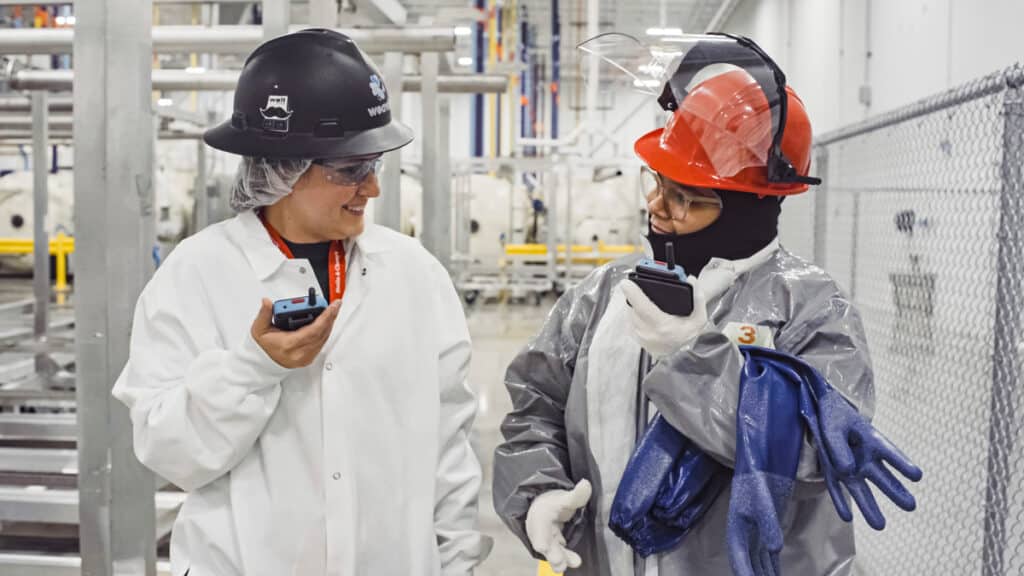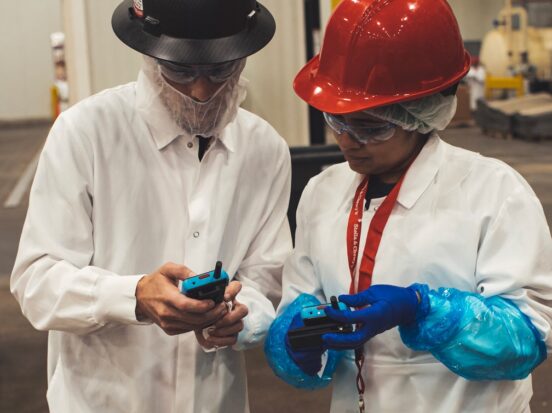What are the most impressive examples of frontline workforce collaboration you can think of? Incredible feats of construction like the Golden Gate Bridge, Gateway Arch, and Empire State Building immediately come to mind, but these only scratch the surface. Most of what keeps our world moving is the stuff we don’t even know about — it’s invisible to us. Without these brave workers, society as we know it would cease to exist.
It would be easy to take frontline workers for granted, though nothing could be further from the truth. When teams work collaboratively, they can accomplish far more than anything they could ever achieve in isolation. Anything that prevents your employees from working together will only slow them down and introduce unnecessary safety risks. And any technology that blocks teamwork has no place in your digital toolkit.
This guide outlines solutions and strategies to boost productivity, employee engagement, and workforce collaboration in frontline environments.
Key Takeaways
- Frontline workforce collaboration is an approach where teams use shared tools and resources to solve problems together, to improve efficiency and teamwork.
- Collaboration in the workplace offers many benefits to the frontline, including greater safety, higher productivity, and better employee engagement.
- Strategies to encourage collaboration at work include regular check-ins and easy access to information, both of which must be tailored to frontline employees.
- The Walt Smart Radio by weavix® lets frontline employees overcome communication barriers and work collaboratively in harsh, hazardous, or noisy conditions.
What Is Frontline Workforce Collaboration?
Frontline workforce collaboration is the process of sharing tools and resources to solve problems collectively, while the opposite would be a group of employees carrying out their tasks in isolation.
Just think about the latter case for a second. When employees don’t work together towards a common goal, they’ll just get in each other’s way. They’ll complete some tasks too soon and others too late, creating safety risks, unnecessary rework, and costly production delays.
Clear communication is the essence of collaboration in the workplace. Without clear communication, your teams won’t gel and collaboration would be impossible. And the result is the same whether those workplace communication barriers are the result of distance, different languages, or simply a failure to coordinate work activities.
In a word, disaster.
But it’s not their fault. For centuries, manual processes have often been insufficient to encourage collaborative work in industrial environments, let alone across multiple locations scattered around the country. It’s only in the last few years that technologies like digital communication platforms, new radio innovations, and AI-powered tools have closed these gaps.

Top Benefits of a Collaborative Workforce on the Frontline
Let’s pause for a moment and return to the workforce where employees operate in complete isolation. In this nightmare, workers rarely communicate with each other, it’s difficult for workers to get answers to their questions, and they’re often unsure of the company’s production goals or overall mission.
We’ve just described an organization with zero frontline workforce collaboration. Now, let’s explore what’s possible when teams center collaboration around connected employees.
1. Safety and Compliance
Why is collaboration so important in the workplace? Because ensuring a safe workspace is impossible without it. Both communication and collaboration can improve safety on the frontlines when everyone feels empowered to speak up before something goes wrong.
A recent study in the Journal of Safety Research found that upward voice is positively correlated with safety performance in High-Reliability Organizations (HROs) like nuclear power plants and chemical facilities. The authors of this study define upward voice as, “the degree to which employees feel free to communicate any concern or challenging information to their superiors.” Clear communication is the essence of workplace collaboration, which also means it’s one of the best ways to keep your team safe.
Perhaps even more strikingly, a separate study in the Journal of Safety Research found a positive relationship between servant leadership and safety behaviors in high-risk industries like manufacturing and construction. Servant leaders are good listeners, empathetic, and excel at building trust, which are the building blocks of clear communication and collaboration in the workplace.
2. Higher Productivity
Any time you’re planning an ambitious target for your team, remember the workers who built the Empire State Building. It only took them 410 days to construct a 102-story landmark from 60,000 tons of steel. This incredible burst of productivity was only possible because every worker trusted every other worker to do their job, and they all joined forces to achieve an audacious goal. The Empire State Building example embodies excellent workforce collaboration.
As any frontline employee can tell you, high productivity is a moving target. The workers who built the Empire State Building had to hit countless production goals to stay on schedule. Clear communication was essential for them to complete the construction of this landmark in record time, just as it’s necessary for your team to get the job done every day.
3. Better Employee Engagement
Why do manufacturing employees quit? The World Economic Forum and McKinsey pinpointed the top reasons in a recent study:
- Frontline workers didn’t feel valued by their organizations (37% cited this as one of their top three reasons for quitting)
- They didn’t feel valued by their managers (36% cited this as one of their top three reasons for leaving their jobs)
- They didn’t see potential for advancement (36% cited this as one of their top three reasons for resigning)
It’s easy to arrive at this point if you feel isolated from your manager and teammates by a host of communication barriers. The harder it is for employees to communicate with each other, the harder it is for them to work collaboratively, and the more likely it is that they’ll quit.
Companies that open new lanes of communication to encourage ongoing collaboration see higher employee retention. Workers who feel valued by their teams, managers, and the larger organization are more likely to stay.
Strategies to Enhance Frontline Collaborative Work
Great teamwork begins with better communication. And when workers trust each other, their manager, and the company’s mission, you’ll see better teamwork. Here are three strategies to promote frontline employee collaboration.
1. Encourage Frequent Team Check-Ins
Team check-ins are a great way to encourage open communication. Plan these meetings so you can prepare for upcoming shifts, celebrate team wins, and address any concerns from members of your team.
Remember, it’s important to find a balance between recognizing your team’s accomplishments and identifying areas to improve. And encouraging effective communication is worth it. McKinsey studied teams that score above average on communication and found they were 2.8 times more efficient, 2.7 times more likely to produce results, and 3.1 times more innovative.

The best way to avoid accidents is to create a safe environment in which everyone feels they can share anything related to the team’s performance, good or bad. Bain discussed the value of psychological safety for effective collaboration among executives, and it’s time to apply this same perspective to frontline teams.
2. Provide Access to Information and Resources
After onboarding, how easily can your workers access the resources they need to perform their jobs well? Is the information readily available, or do they have to spend time tracking it down?
If it’s difficult for your team members to get this information, this will become another obstacle to enterprise-wide collaboration. Multiply this across your entire workforce, and it can quickly impact team morale as well as your safety and production goals.
The solution? Open up communication channels among different teams, document those channels, and leave them open for everyone. Here’s what that looks like in practice:
- Give people a way to get answers to their questions quickly. Whether it’s details about a specific piece of machinery, an update on a maintenance request, or information on employment benefits, workers should be able to get answers in seconds through effective communication solutions.
- Show them their work matters by connecting them with team members from different departments. The worst thing you can do for collaboration is isolate individuals and departments. For example, smart radios allow you to set up channels to document safety milestones or even big customer wins. Connect different teams to show everyone you’re all working towards the same goals.
- Preserve a record of your communications so nothing slips through the cracks. If you want to receive a message on most rugged radios, you need to be within earshot at all times and within close range. New smart radio technologies with AI translation and transcription dictate all incoming messages aloud while also recording them as text threads, so everyone can stay informed at all times.
3. Empower Every Worker with Workforce Collaboration Tools
All the strategies in the world won’t be enough to improve collaboration in your organization, unless you also provide your team with tools to communicate in real-time. But how do you choose the right tools for your team? Here are some best practices:
- Remove as many communication barriers as possible. Look for devices that can translate common languages with unlimited range.
- Consider your frontline employees’ work environment. Explore tools that are suitable for hazardous, damp, or noisy conditions.
- Select a communication platform built for frontline teamwork. Isolated devices lead to siloed communication. If you want to encourage effective collaboration, you need more than walkie-talkies.
Teamwork breaks down if only a small percentage of your workers are enabled with communication devices. What message does it send to your frontline employees if you say you value frontline team collaboration, but don’t give them the means to communicate?
When we weigh all these factors, the solution is clear. The best tools are stand-alone, rugged workforce collaboration tools.
Why Smartphones Simply Don’t Work as Frontline Staff Collaboration Tools
Frontline staff collaboration tools can make teamwork much easier, but only if they’re implemented correctly. Consumer products like personal smartphones are the perfect example of this, though perhaps not for the reasons you think.
- Safety risks abound with personal smartphones. They’re not rugged and waterproof, and they’re not suitable for Class 1 Div 2 environments. And if you take off your work gloves to use your smartphone, that’s a safety risk.
- Liability is a huge concern if workers are permitted to bring their personal smartphones onto the worksite. What happens if a worker takes a picture of your proprietary technology and sends it to one of their friends? What if they text someone those details? You wouldn’t know about it until it shows up in the news.
- Productivity will drop if workers are allowed to use their personal devices while they’re on shift, since smartphones provide countless opportunities for distraction.
These are all reasons why Bring Your Own Device (BYOD) policies can’t improve collaboration at work. And these same concerns also apply to workforce collaboration apps that live on your employees’ personal phones. Any upside for these apps is far outweighed by the significant downsides we just mentioned.
And the kicker? Workers hate BYOD programs, since they want to keep their personal lives separate from their jobs anyway.
What workers really need is a device that’s even easier to use than a smartphone, without all the downsides of consumer devices. Fortunately, devices like this exist today, and they can enable collaboration at work while driving multiple benefits for your team.
Keep reading: Explore 7 reasons why phones don’t work for the frontline
Best Communication Tools to Boost Collaboration in the Workplace
As we’ve seen throughout this article, clear communication is the key to effective frontline workforce collaboration. The only way your team can stay safe, productive, and engaged is if they can communicate with each other. And this will only be possible if everyone has a rugged communication device.
But as we’ve seen, it’s not enough to just give everyone a standard walkie-talkie and call it a day. The best frontline employee collaboration tools enable everyone on your team to share real-time updates according to their preference and the surrounding environment. Whether your worksite is dusty, damp, hazardous, or noisy, a waterproof, rugged radio is the way to go.
| Collaboration Tools | Why They Matter To Your Frontline Workforce |
|---|---|
| PT3 |
|
| AI-Powered Language Translation |
|
| Alerting System |
|
| Dictation and Text-to-Speech |
|
Power Frontline Collaboration with weavix
Clear communication is essential on the frontlines. From the workers who built the Empire State Building to the teams you manage today, we can all do so much more when we work together. But excellent work in collaboration doesn’t happen by chance. You need the right communication strategies and the right tools to build the best communication plan for your organization.
We designed the Walt Smart Radio System for frontline workforce collaboration. This comprehensive communications platform includes all the collaboration tools we mentioned above, so your workers will have everything they need to connect with each other in any situation.
While most radios do little to break down communication silos, Walt creates a network of accountability that spans your entire organization. Contact us to see how Walt can unite your frontline teams for better collaboration at work.
 Andrew Rhodes
Andrew Rhodes 
